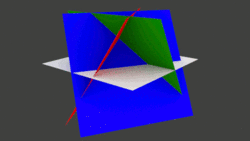Cake number

In mathematics, the cake number, denoted by Cn, is the maximum of the number of regions into which a 3-dimensional cube can be partitioned by exactly n planes. The cake number is so-called because one may imagine each partition of the cube by a plane as a slice made by a knife through a cube-shaped cake. It is the 3D analogue of the lazy caterer's sequence.
The values of Cn for n = 0, 1, 2, ... are given by 1, 2, 4, 8, 15, 26, 42, 64, 93, 130, 176, 232, ... (sequence A000125 in the OEIS).
General formula
If n! denotes the factorial, and we denote the binomial coefficients by
and we assume that n planes are available to partition the cube, then the n-th cake number is:[1]
Properties
The only cake number which is prime is 2, since it requires to have prime factorisation where is some prime. This is impossible for as we know must be even, so it must be equal to , , , or , which correspond to the cases: (which has only complex roots), (i.e. ), , and .[citation needed]
The cake numbers are the 3-dimensional analogue of the 2-dimensional lazy caterer's sequence. The difference between successive cake numbers also gives the lazy caterer's sequence.[1]
The fourth column of Bernoulli's triangle (k = 3) gives the cake numbers for n cuts, where n ≥ 3.
The sequence can be alternatively derived from the sum of up to the first 4 terms of each row of Pascal's triangle:[2]
- kn
0 1 2 3 Sum 1 1 — — — 1 2 1 1 — — 2 3 1 2 1 — 4 4 1 3 3 1 8 5 1 4 6 4 15 6 1 5 10 10 26 7 1 6 15 20 42 8 1 7 21 35 64 9 1 8 28 56 93 10 1 9 36 84 130
Other applications
In n spatial (not spacetime) dimensions, Maxwell's equations represent different independent real-valued equations.
References
External links
- Eric Weisstein. "Space Division by Planes". http://mathworld.wolfram.com/SpaceDivisionbyPlanes.html.
- Eric Weisstein. "Cake Number". http://mathworld.wolfram.com/CakeNumber.html.
 |
